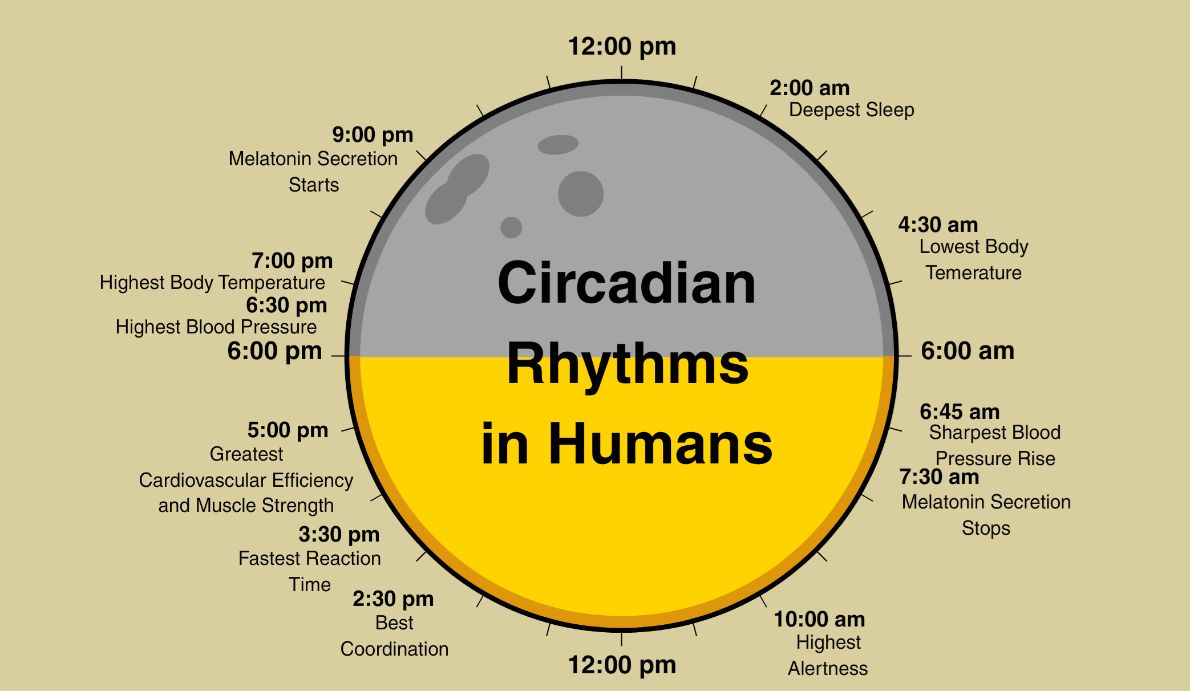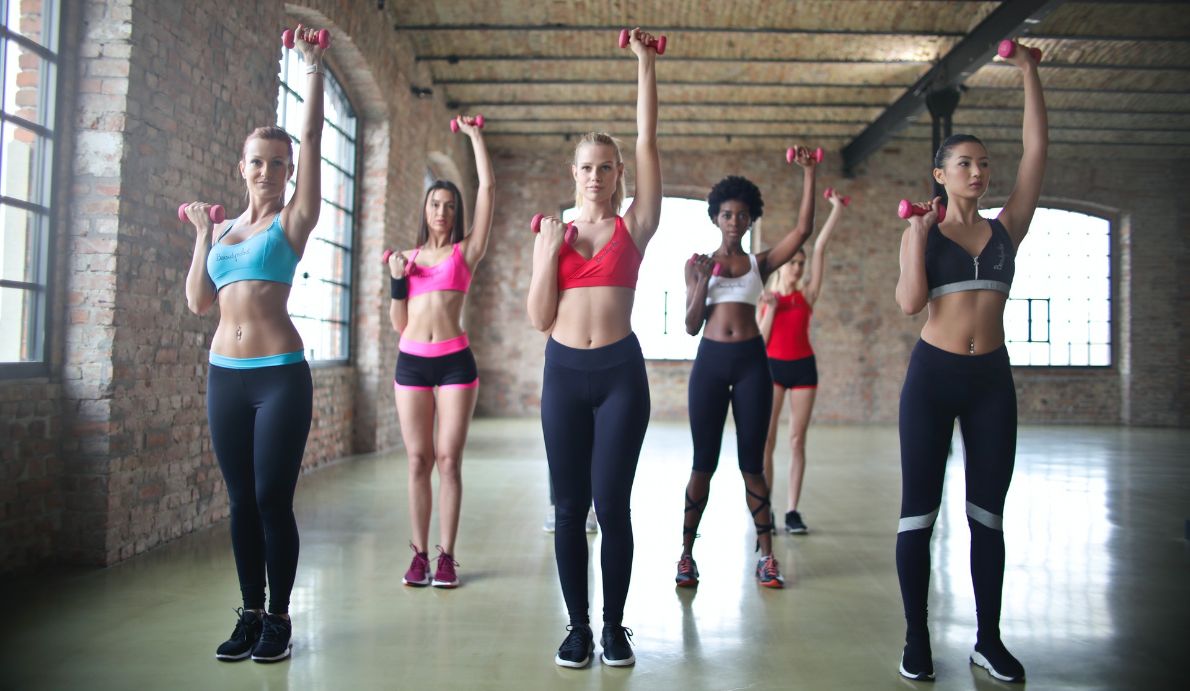The level of blood pressure is one of the key vital signs of the human body: it defines the state of health. Сhanges in the blood pressure level show how the human body is ready to adapt to the external environment. Such changes are important to take into account when measuring blood pressure, diagnosing and prescribing therapy.
Circadian rhythms
Our circadian rhythm consists of a sleep-wake cycle. This cycle is the most understandable example of circadian rhythms: cyclical changes in the body tied to the change of day and night. This internal clock keeps ticking even if there is no information about the current time of day. They are sewn into the genome and limit the time of organism activity in order to enable it to recover [1].

One of the main elements that maintain circadian rhythms is considered to be a small group of neurons in the brain, located in the suprachiasmatic nucleus of the hypothalamus. The same part of the brain is responsible for the production of the hormone vasopressin, which has an evident impact on blood pressure levels. Thus, the level of blood pressure is partly regulated by circadian rhythms. During sleep and 30-60 minutes after it, the blood pressure may be lower by 20-40 mm Hg than typical for a person in a state of wakefulness [6].
Weather
A sharp change in atmospheric pressure can lead to the development of headache and dizziness [6].Being influenced by the external environment, the body tries to balance the external pressure with the internal one. Vascular tone changes, this leads to a sharp increase or decrease in blood pressure, which affects the level of oxygen in the tissues and sometimes takes the form of pain. A similar scheme is observed in situations when the height above sea level changes: when climbing the mountains, flying, moving a long distance [7,8].
A sharp change in ambient temperature can also provoke a jump in blood pressure by 10-15 mm Hg. This applies to both a decrease and an increase in temperature, including its seasonal changes [6,7]. That is why it is not recommended to attend sauna with arterial hypertension.

Most often, such rapid changes in external conditions occur when traveling long distances, for example, on vacation away from home. The most painful such changes are perceived by weather-dependent people and patients with hypertension. Until recently, a trip meant a break from the usual life, the inability to visit a doctor or measure blood pressure on a home blood pressure monitor. However, modern models are compact in size. A wrist blood pressure monitor can be a convenient device for these situations. It is lightweight, takes up little space, but is as accurate as fixed devices.
Physical activity
Jogging or strength training increases blood pressure during exercise. Usually it is higher on 20-30 mm Hg. When lifting significant weights, the level of blood pressure can rise up to 40-50 mm Hg. Art. [3, 5]. The blood pressure remains elevated for another hour after exercise, and then decreases to normal level. At the same time, a decrease in blood pressure a few hours after exercise to a level slightly lower than usual is also the norm.
In professional athletes, blood pressure changes less and more smoothly. In amateur athletes or people with chronic diseases, sudden pressure drops are possible [3, 10].

Controlling the level of blood pressure during sports is especially important in cases of chronic diseases of the cardiovascular system [5, 9]. Since sports often take place outside home, this is another category of people for whom a compact wrist blood pressure monitor can be recommended.
Stress, psychological and emotional conditions
Strong emotions (both negative and positive) trigger the activation of the sympathicoadrenal axis, a long chain from the brain to the adrenal glands, which leads to the release of hormones into the bloodstream, such as adrenaline [1]. Adrenaline makes the heart beat faster and leads to vasoconstriction. In such situations, blood pressure rises. This is one of the reasons why people with cardiovascular disease are advised to avoid strong emotional experiences.

Chronic stress is an important factor in the development of hypertension. In urban conditions, it is provoked by increased noise, an abundance of artificial light and the syndrome of professional burnout [1, 2, 4]. Studies show that men in general cope worse with these factors than women. Only 5 years of work associated with negative emotions is enough for the development of hypertension [2, 10]. Women are also confirmed to be influenced by an unfavorable environment, however, for the development of hypertension, the duration and strength of environmental factors must be greater than in the case of men.
Other external factors
In addition to the factors described above, the World Health Organisation (WHO) and specialized associations for the study of hypertension note the following most common reasons for an increase in blood pressure levels:
- unbalanced nutrition (excessive consumption of table salt and caffeine) [5, 9, 10, 11],
- poor environmental conditions (high levels of lead, cadmium, mercury) [6],
- use of certain drugs, which side effects can increase blood pressure (for example, steroids) [5, 8],
- smoking [9, 10, 11].
If a person experiences an increase in blood pressure two or more times a week, then this is one of the signs of a high risk of developing hypertension [5]. That is why therapists recommend keeping a health diary and recording observations of your health condition in order to consult a doctor in time. In such a diary, it is worth writing information about sleep patterns, periods of fatigue, heart rate and blood pressure level. A blood pressure monitor with measurement memory function can track the dynamics of changes and help in filling out a health diary.
1.Pickering T. G. (1997). The effects of environmental and lifestyle factors on blood pressure and the intermediary role of the sympathetic nervous system. Journal of human hypertension, 11 Suppl 1, S9–S18.
2. Ohlin, B., Berglund, G., Rosvall, M., & Nilsson, P. M. (2007). Job strain in men, but not in women, predicts a significant rise in blood pressure after 6.5 years of follow-up. Journal of hypertension, 25(3), 525–531. https://doi.org/10.1097/HJH.0b013e32801220fa
3.Currie, K.D., Floras, J.S., La Gerche, A. et al. Exercise Blood Pressure Guidelines: Time to Re-evaluate What is Normal and Exaggerated?. Sports Med 48, 1763–1771 (2018). https://doi.org/10.1007/s40279-018-0900-x
4.Pickering, T. G., Devereux, R. B., James, G. D., Gerin, W., Landsbergis, P., Schnall, P. L., & Schwartz, J. E. (1996). Environmental influences on blood pressure and the role of job strain. Journal of hypertension. Supplement : official journal of the International Society of Hypertension, 14(5), S179–S185.
5.Campbell, N. R., Burgess, E., Choi, B. C., Taylor, G., Wilson, E., Cléroux, J., Fodor, J. G., Leiter, L. A., & Spence, D. (1999). Lifestyle modifications to prevent and control hypertension. 1. Methods and an overview of the Canadian recommendations. Canadian Hypertension Society, Canadian Coalition for High Blood Pressure Prevention and Control, Laboratory Centre for Disease Control at Health Canada, Heart and Stroke Foundation of Canada. CMAJ : Canadian Medical Association journal = journal de l'Association medicale canadienne, 160(9 Suppl), S1–S6.
6.Brook, R. D., Weder, A. B., & Rajagopalan, S. (2011). "Environmental hypertensionology" the effects of environmental factors on blood pressure in clinical practice and research. Journal of clinical hypertension (Greenwich, Conn.), 13(11), 836–842. https://doi.org/10.1111/j.1751-7176.2011.00543.x
7.Modesti P. A. (2013). Season, temperature and blood pressure: a complex interaction. European journal of internal medicine, 24(7), 604–607. https://doi.org/10.1016/j.ejim.2013.08.002
8.Strapazzon, G., & Semplicini, A. (2009). Should travelers with hypertension adjust their medications when traveling to high altitude?. High altitude medicine & biology, 10(3), 305–306. https://doi.org/10.1089/ham.2009.1021
9.Touyz, R. M., Campbell, N., Logan, A., Gledhill, N., Petrella, R., Padwal, R., & Canadian Hypertension Education Program (2004). The 2004 Canadian recommendations for the management of hypertension: Part III--Lifestyle modifications to prevent and control hypertension. The Canadian journal of cardiology, 20(1), 55–59.
10.Samadian, F., Dalili, N., & Jamalian, A. (2016). Lifestyle Modifications to Prevent and Control Hypertension. Iranian journal of kidney diseases, 10(5), 237–263.
11.Ozemek, C., Laddu, D. R., Arena, R., & Lavie, C. J. (2018). The role of diet for prevention and management of hypertension. Current opinion in cardiology, 33(4), 388–393. https://doi.org/10.1097/HCO.0000000000000532
Photo Credit: The KU project, Pexels
 Global - English
Global - English 
 Germany
Germany
 Albania
Albania
 France
France
 Bosnia and Herzegovina
Bosnia and Herzegovina
 Austria
Austria
 Bulgaria
Bulgaria
 Switzerland
Switzerland
 Croatia
Croatia
 Cyprus
Cyprus
 Denmark
Denmark
 Estonia
Estonia
 Finland
Finland
 Greece
Greece
 Hungary
Hungary
 Kosovo
Kosovo
 Latvia
Latvia
 Lithuania
Lithuania
 Macedonia
Macedonia
 Malta
Malta
 Moldova
Moldova
 Montenegro
Montenegro
 Norway
Norway
 Poland
Poland
 Romania
Romania
 Russia
Russia
 Serbia
Serbia
 Slovenia
Slovenia
 Slowakia
Slowakia
 Spain
Spain
 Sweden
Sweden
 Ukraine
Ukraine
 Armenia
Armenia
 Azerbaijan
Azerbaijan
 Georgia
Georgia
 Jordan
Jordan
 Kazakhstan
Kazakhstan
 Kuwait
Kuwait
 Lebanon
Lebanon
 Malaysia
Malaysia
 Mongolia
Mongolia
 Oman
Oman
 Pakistan
Pakistan
 Qatar
Qatar
 Saudi Arabia
Saudi Arabia
 Sri Lanka
Sri Lanka
 United Arab Emirates
United Arab Emirates
 Uzbekistan
Uzbekistan
 Vietnam
Vietnam
 Azerbaijan
Azerbaijan
 Georgia
Georgia
 Bolivia
Bolivia
 Colombia
Colombia
 Algeria (Arabic)
Algeria (Arabic)
 Algeria (French)
Algeria (French)
 Egypt
Egypt
 Mauritius
Mauritius
 Morocco
Morocco
 Nigeria
Nigeria
 Republic of South Africa
Republic of South Africa
 International
International




